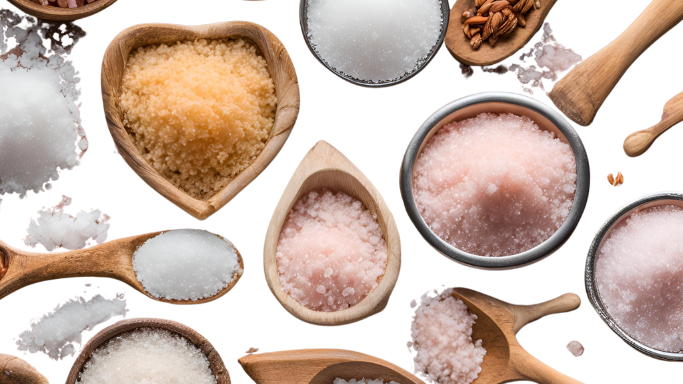Salt is an essential ingredient in kitchens worldwide, bringing flavor and enhancing taste in all sorts of dishes. However, there’s much more to salt than the table salt most of us grew up with. Each type of salt varies in flavor, mineral content, and texture, making some better suited for specific dishes and culinary applications. Here’s a complete guide to understanding the different types of salt and how to make the most of them in your cooking.
Table Salt
Table salt, often simply labeled as “salt,” is the most commonly used type. It’s finely ground, highly processed, and typically contains anti-caking agents to prevent clumping. Table salt is also usually iodized, meaning it has added iodine, which is essential for thyroid health. This salt dissolves quickly and is ideal for baking or recipes where salt needs to blend seamlessly.
Kosher Salt
Kosher salt is a popular choice among chefs due to its coarse texture and lack of additives. Named for its traditional use in koshering meat, it has a cleaner, less intense flavor than table salt. Kosher salt is easy to pinch and sprinkle, making it ideal for seasoning dishes during and after cooking.
Sea Salt
Harvested directly from evaporated seawater, sea salt is less processed than table salt and retains trace minerals like magnesium, potassium, and calcium. These minerals give sea salt a more complex flavor profile. Sea salt comes in different forms and grain sizes, from coarse crystals to fine flakes, and it’s excellent for finishing dishes with a delicate crunch.
Himalayan Pink Salt
Sourced from ancient salt deposits in Pakistan, Himalayan pink salt has a distinctive pink color due to trace minerals like iron. Often used for its purported health benefits, Himalayan salt has a mild, earthy flavor and is popular in both cooking and as a decorative finishing salt. It’s also used in salt lamps and spa treatments for its aesthetic appeal and supposed air-purifying effects.
Fleur de Sel
Fleur de Sel, meaning “flower of salt,” is a rare, delicate sea salt hand-harvested from salt ponds in regions like France. This salt forms as a fine crust on the surface of the water and has a subtle flavor with a moist texture. Fleur de Sel is highly prized as a finishing salt, perfect for sprinkling on dishes right before serving to enhance flavor and add texture.
Smoked Salt
Smoked salt is typically sea salt that has been smoked over a wood fire, imparting a deep, smoky flavor to the crystals. It’s ideal for adding a hint of smokiness to dishes without the use of actual smoke, making it a great addition to grilled meats, vegetables, or hearty stews.
Black Salt (Kala Namak)
Popular in Indian and Southeast Asian cuisines, black salt, or Kala Namak, has a strong sulfuric aroma and a unique flavor. This salt is often used in vegan cooking as it mimics the taste of eggs. With its deep, earthy flavor, black salt is commonly added to chutneys, salads, and savory snacks.
With so many varieties to choose from, each type of salt offers a unique twist to your culinary creations. Understanding the distinct characteristics of each type can help you elevate your cooking and add depth to your dishes. Try experimenting with different salts to discover how a simple ingredient can transform flavors in exciting ways.




